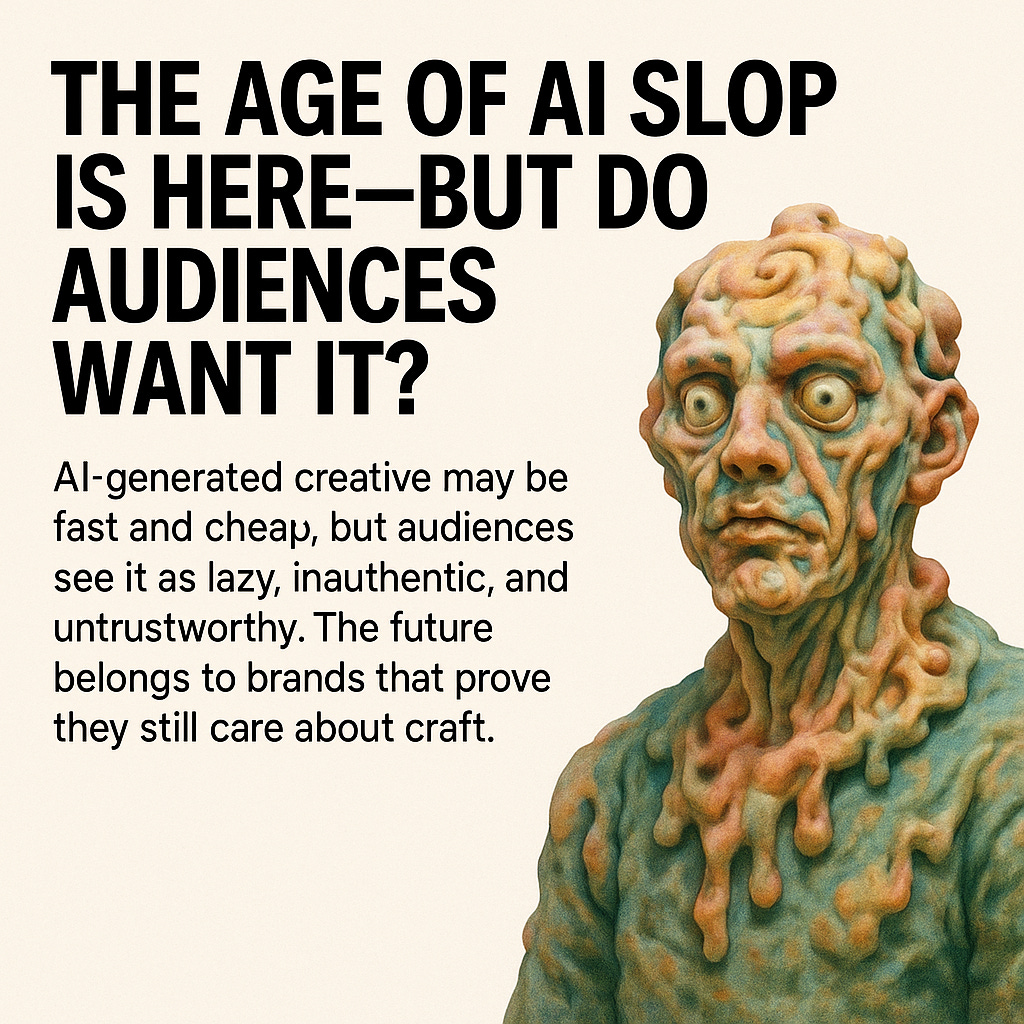What Your AI Content Really Says About Your Brand
AI-generated creative may be fast and cheap, but audiences see it as lazy, inauthentic, and untrustworthy. The future belongs to brands that prove they still care about craft.
Happy Saturday!
I’m dropping into your inbox from beautiful Bogotá, Colombia, with a special edition on what using AI in your content communicates to your audiences.
Let’s dive in,
Ryan
The Age of AI Slop Is Here—But Do Audiences Want It?
Whether you like it or not, AI content is all over your social media feeds and is also being forced on us by startups adding clunky AI features nobody asked for.
You don’t get to choose. You’re never asked. It just shows up. Now you have to deal with it.
I don’t want AI customer service—but I don’t get a choice.
I don’t want AI responses to my Google searches—but I don’t get a choice.
I don’t want AI integrated into my software—but I don’t get a choice.
I don’t want AI sending me emails—but I don’t get a choice.
I don’t want AI music on Spotify—but I don’t get a choice.
I don’t want AI books on Amazon—but I don’t get a choice.
The networks are struggling to contain the problem, as AI slop overwhelms YouTube, Meta, Pinterest, and more.
“The age of slop is inevitable,” said Ajder, who is also an AI policy advisor at Meta, which owns Facebook and Instagram. “I’m not sure what we do about it.”
Yet, even as social media leaders fret about the threat of AI slop, they rush to embrace it as a total replacement for human-led advertising creative.
TikTok has insisted it’s not sidelining agencies. But the expansion of Symphony’s AI-driven creative suite paints another picture. These tools let brands generate content quickly and autonomously without intermediaries.
Meta is taking a similar approach. While continuing to invest in agency communications, it’s clearly building toward a future where advertisers can efficiently generate campaigns—including creative and targeting—within its platforms.
Google, Amazon, and even Comcast are pushing similar tools; the latter will launch a free, AI-driven commercial generator this summer, adding pressure on agencies to compete with platforms' self-serve efficiencies.
One audience to completely embrace AI slop as an aesthetic is the Trump/MAGA right.
AI slop has become the aesthetic of the right, with authoritarians around the world embracing ugly, lazy, mass-produced content like PragerU’s founding father puppets. Here in the U.S., we have President Donald Trump hawking it on his social media accounts, including AI-generated images of himself as the Pope and “Trump Gaza,” an AI video and song depicting the West Bank as a vacation paradise where Trump parties alongside his former bestie Elon Musk. As Republicans used the response to Hurricane Helene to blame migrants, Amy Kremer, founder of Women for Trump, posted an AI image of a child caught in a flood hugging a puppy and then said she didn’t care that it wasn’t real: “Y’all, I don’t know where this photo came from and honestly, it doesn’t matter,” she wrote on X. Mike Lee shared the same image. AI slop makes for quick and easy engagement farming, and now it’s being produced in direct partnership with the White House.
Audiences Don’t Like or Trust AI Content
Chances are your audiences don’t like or trust AI content.
“It destroys the purpose of humanity. We have so many amazing abilities to create art and music and just appreciate what’s around us,” said Kayla Ellsworth, a 21-year-old college student. “Some of the things that are the most important to us are being replaced by things that are not real.”
71% of Americans said they wouldn’t pay extra for AI features in a product they already use.
“Consumers intuitively identified most of the AI-generated ads, perceiving them as less engaging and more “annoying,” “boring,” and “confusing” than traditional ads. These sentiments suggest that AI-generated ads may create a negative halo effect that could dampen consumer perceptions of both the ad and the brand.”
70% of global consumers would be uncomfortable consuming fully AI-generated creative content. 54% would be uncomfortable with AI-assisted creative content.
46% of consumers dislike companies that use AI to generate content, and 43% are less likely to purchase from such a company.
AI slop is so bad on social media, it degrades the results of paid advertising around it:
The trust damage doesn’t stop at content alone, spilling over to the ads placed alongside AI content, according to Raptive’s study. People who saw ads placed adjacent to content they perceived as AI-generated rated them 17% less premium, 19% less inspiring, 16% more artificial, 14% less relatable, and 11% less trustworthy.
People Over Slop
Brands that use AI images or videos on social—whether perceivable or not—are making a statement to the consumer about craft. If your brand cares about how your product is made, then it would seem incongruous to use AI to mimic the style of a maker. For example, it surprised me when Sweetgreen—a company that highlights farmers and well-sourced ingredients—participated in the Studio Ghibli trend. As Elizabeth told me, “AI usage communicates a lack of investment or care to me—either in budget, time, or creative team infrastructure. Viewers care about how things are made, even if they don’t always know how to articulate it. If a brand can’t be bothered to write its own product detail page copy, why should I trust they’ve vetted their ingredients? If they’re outsourcing their social content, what else are they cutting corners on?”
Smart brands and organizations won’t rely on pure AI content production but will use AI as a planning and creative partner. To project quality and trustworthiness, they’ll recognize the need for real people in their marketing.
I predict we’ll see more posts like Apple TV’s BTS of how their camera operator got a very impressive shot in The Studio. Chamberlain Coffee captioning how their claymation campaign came together with “handcrafted, just like our coffee.” Topicals simply tagging every single creative who worked on a video. It will become social media currency for the brands that abstain from using AI in creative to share their “proof of reality”. The polite way of saying “AI could never”.
Influencer Impact On Deja & Creator Rates
The recent Influencer Impact: Strategist Edition looks at two sides of the creator economy. Nicole Dunger breaks down Deja Foxx’s run for Congress and what it reveals about the gap between national reach and local votes. And I dive into why creator rates keep climbing and why capturing their attention is becoming the real challenge.




I hope decision making ppl are listening. always knew the market would not allow this and it will become increasingly so.